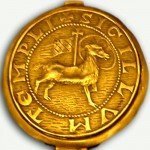Knights Templar Banking
The Banking System formed by The Knights Templar was the first of it’s kind. They collected interest, charged fees, and issued checks. Essentially, the Knights Templar Banking system was the world’s first international corporation.
Knights Templar Banking Built from Poverty
The Knights Templar took a vow of poverty and were founded with little resources. Their poverty, however, did not last very long. A series of papal bulls allowed the Templars to keep whatever resources, gold or otherwise, that they had acquired during their battles. Furthermore, gifts that were given to the Templars from European Christians help the Templars to build a vast fortune. Finally, when a Knight was initiated into the Order, all worldly possessions of his, land, gold and otherwise, because property of the Knights Templar. In their height, the Templars had roughly 800 castles along with vast amounts of land and gold. It didn’t take long for the Templars to realize that their castles could easily function as full service banks.
Banking System of Deposits and Loans
Knights could deposit money in Europe, and make a withdrawal in Jerusalem when their journey was complete. In addition, the Templars also allowed pilgrims to use this service. A pilgrim in would deposit their money at any castle throughout Europe and be given a note. Essentially, the Knights Templar were handing out the first checks ever. The pilgrim would then make the passage to the holy lands, which was much safer when there was no money for robbers to be attracted to. Once in Jerusalem, they would visit withdraw their gold coins.
In addition to deposit type accounts, the Knights Templar also set up loans to various nobles and monarchs. Monarchs would borrow from the Knights in order to finance their own desires and financing war. The most heavily in debt was King Philip of France. King Philip borrowed from the Knights Templar finance wars at the time. He approached the Knights in order to further borrow to finance the Hundred Years War with the English. King Philip’s request was denied by the Templars, and the infuriated king mounted an attack that lead to the eventual downfall of the Knights Templar.

